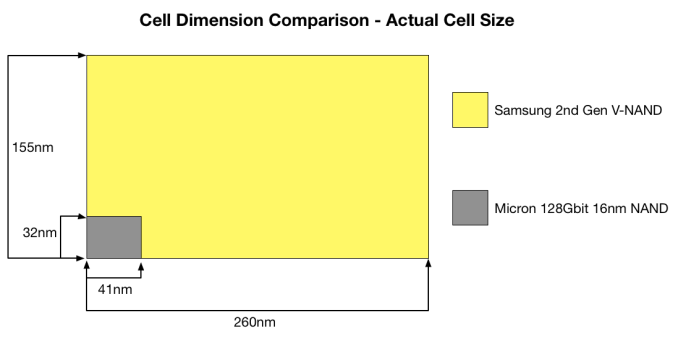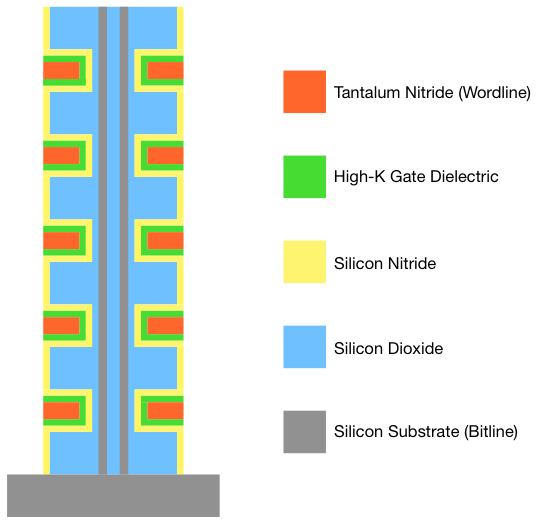Samsung SSD 850 Pro (128GB, 256GB & 1TB) Review: Enter the 3D Era
by Kristian Vättö on July 1, 2014 10:00 AM EST3D NAND: Hitting The Reset Button on Scaling
Now that we understand how 3D NAND works, it is time to see what it is all about. As we now know, the problem with 2D NAND is the shrinking cell size and the proximity of the cells, which results in degraded reliability and endurance. Basically, 3D NAND must solve these two issues but it must also remain scalable to be economical. So how does it do that? This is where the third dimension comes into play.
The cost of a semiconductor is proportional to the die size. If you shrink the die, you effectively get more dies from a single wafer, resulting in a lower cost per die. Alternatively you can add more functionality (i.e. transistors) to each die. In the case of NAND, that means you can build a higher capacity die while keeping the die size the same, which gives more gigabits per wafer and thus reducing cost. If you cannot shrink the die, then you have just hit a dead-end because the cost will not scale. That is what has happened with 2D NAND because the shrinks on X and Y axes have run out of gas.
What 3D NAND does is add a Z-axis to the game. Because it stacks cells vertically, it is no longer as dependent on the X and Y axes since the die size can be reduced by adding more layers. As a result, Samsung's V-NAND takes a more relaxed position on the X and Y axes by going back to a 40nm process node, which increases the cell size and leaves more room between individual cells, eliminating the major issues 2D NAND has. The high amount of layers compensates for the much larger process node, resulting in a die that is the same size and capacity as the state of the art 2D NAND dies but without the caveats.
The above graph gives some guidance as to how big each cell in V-NAND really is. On the next page, I will go through the method of how cell size is really calculated and how V-NAND compares with Micron’s 16nm NAND but the above gives a good picture of the benefit that 3D NAND has. Obviously, when each cell is larger and the distance between individual cells is higher, there are more electrons to play with (i.e. more room for voltage state changes) and the cell to cell interference decreases substantially. Those two are the main reasons why V-NAND is capable of achieving up to ten times the endurance of 2D NAND.
Moreover, scaling in vertical dimension does not have the same limitations as scaling in the X and Y axes do. Because the cost of a semiconductor is still mostly determined by the die area and not by the height, there is no need to cram cells very close to each other. As a result, there is very little interference between the cells even in the vertical direction. Also, the usage of high-K dielectrics means that the control gate does not have to wrap around the charge trap. The result is that there is a hefty barrier of silicon dioxide (which is an insulator) between each cell, which is far more insulating than the rather thin ONO layer in 2D NAND. Unfortunately, I do not know what is the exact distance between each cell in the vertical dimension but I think it is safe to assume that it is noticeably more than the ~20nm in 2D NAND since there is no need for aggressive vertical scaling.
As for how far Samsung believes their V-NAND can scale, their roadmap shows a 1Tbit die planned for 2017. That is very aggressive because it essentially implies that the die capacity will double every year (256Gbit next year, 512Gbit in 2016 and finally 1Tbit in 2017). The most interesting part is that Samsung is confident that they can do this simply by increasing the layer count, meaning that the process node will stay at 40nm.












160 Comments
View All Comments
frenchy_2001 - Tuesday, July 1, 2014 - link
the 3D structure and design are revolutionary, but the manufacturing technology is actually a very mature one (40nm). This makes it *MUCH* cheaper than the 1X used by their competition.Samsung has really struck gold with that design, as it allows them to scale in both dimensions, depending on the result and cost of each. While 2D NAND is facing really tough challenges to increase density, V-NAND is allowed to either scale up (more layers) or restart scaling pitch, as manufacturing is *very well* understood from 40nm->~16nm. They just need to experiment with it and see what makes economic sense and good trade-offs.
toyotabedzrock - Tuesday, July 1, 2014 - link
Almost seems like it would be cheaper to ramp up the production of silicon ingots and drive that cost down further than the r&d for this.frenchy_2001 - Tuesday, July 1, 2014 - link
Silicon ingots cost is marginal. The real cost for scaling is all the R&D necessary to make the pitch smaller. Even using bigger wafers (current ones are 300mm, there have been talks of 450mm for a while, but cost is a deterrent, as a whole fab needs to be re-tooled for the upgrade) only improves yields and costs marginally.NAND scaling down is facing huge challenges, due both to process (who to image those ~15nm line on a wafer) and electrical limits (~3 electrons inside your cell at 15nm). 3D NAND allows to restart the growth by bypassing those challenges (step back to 40nm process and scale in the Z axis).
General SOCs are facing similar process limits (there is no solution below 10nm so far, despite the whole industry cooperating to find one), even if their design limits are more relaxed (SOCs are not trapping charges, but cross talk and interference are starting to be challenges too).
UltraWide - Monday, June 30, 2014 - link
Will there be a version with PCIe or M.2?Gigaplex - Monday, June 30, 2014 - link
If you'd read the article, you'd know the controller doesn't support PCIe.Gigaplex - Monday, June 30, 2014 - link
"This further suggests that the issue lies in our tests instead of the RAPID software itself as end-users will always run the drive with a partition anyway."Um, no. I don't care what the end user does, the software shouldn't cause a BSOD. If it can't cache without a partition, it should simply not attempt to cache. This is just a case of Samsung thinking that just because they do some nice hardware, that they're experts in software. They're really not. RAM caching of I/O isn't specific to SSDs anyway, why are they tying it to an SSD launch?
Donuts123 - Wednesday, July 2, 2014 - link
Yeah, that's a huge red flag for me, I definitely wouldn't use the RAPID software. Another layer to go wrong (and apparently it does). I hope Anandtech submits details of the BSODs they saw to Samsung.RAPID probably just uses the Samsung SSD as a dongle. Presumably RAPID is derived from Samsung's acquisition of NVELO, see http://www.anandtech.com/show/6518/samsung-acquire...
Guspaz - Monday, June 30, 2014 - link
Wait a minute, 150TB endurance on a 1TB drive? Only 150 cycles? That doesn't make any sense, that's absurdly low.Then again, Intel's rating for the 335 doesn't make any sense either. They say 20GB a day for 3 years, or about 22TB... But they also rate it for 3000 cycles, and the media wear indicator on the drive is set to treat 3000 as full wear, and that represents 720TB...
Kristian Vättö - Tuesday, July 1, 2014 - link
The endurance figures are usually based on a 4KB random write workload and are thus worst-case numbers. 150TB of random writes means a ton of more NAND writes than 150TB, that's why. I explained the calculation of TBW here:http://www.anandtech.com/show/7947/micron-m500-dc-...
However, as I mentioned in the article, in the client space the endurance is more for guidance (i.e. don't put these in servers!) than an actual technical limit.
emn13 - Tuesday, July 1, 2014 - link
...but outside of server-like workloads, what's going to benefit from this performance?